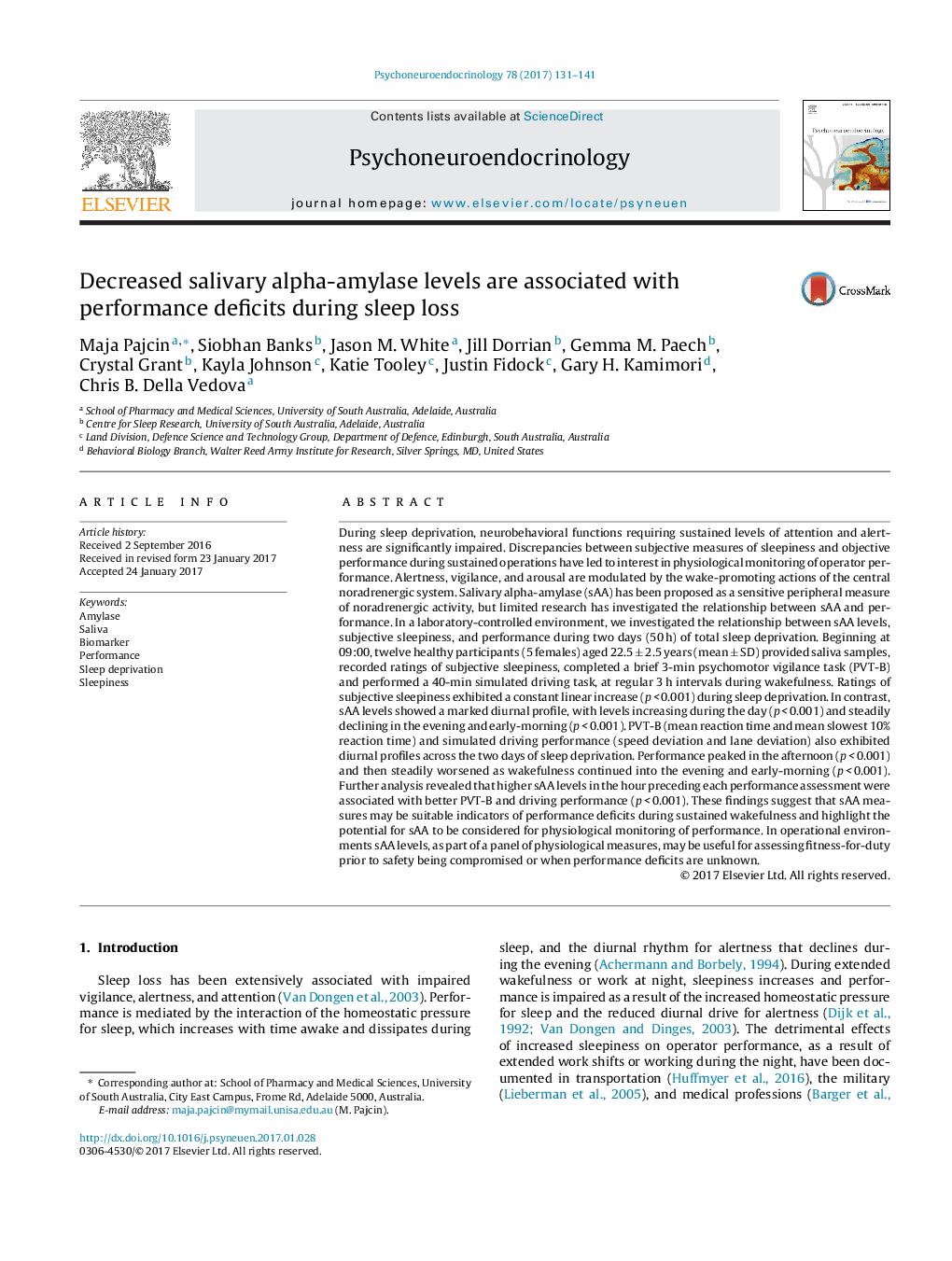| کد مقاله | کد نشریه | سال انتشار | مقاله انگلیسی | نسخه تمام متن |
|---|---|---|---|---|
| 4934493 | 1433965 | 2017 | 11 صفحه PDF | دانلود رایگان |
عنوان انگلیسی مقاله ISI
Decreased salivary alpha-amylase levels are associated with performance deficits during sleep loss
ترجمه فارسی عنوان
کاهش سطح آلفا آمیلاز بزاق با کمبود عملکرد در هنگام از دست دادن خواب همراه است
دانلود مقاله + سفارش ترجمه
دانلود مقاله ISI انگلیسی
رایگان برای ایرانیان
کلمات کلیدی
آمیلاز، بزاق، بیومارکر، کارایی، محرومیت از خواب، خوابیدن
موضوعات مرتبط
علوم زیستی و بیوفناوری
بیوشیمی، ژنتیک و زیست شناسی مولکولی
علوم غدد
چکیده انگلیسی
During sleep deprivation, neurobehavioral functions requiring sustained levels of attention and alertness are significantly impaired. Discrepancies between subjective measures of sleepiness and objective performance during sustained operations have led to interest in physiological monitoring of operator performance. Alertness, vigilance, and arousal are modulated by the wake-promoting actions of the central noradrenergic system. Salivary alpha-amylase (sAA) has been proposed as a sensitive peripheral measure of noradrenergic activity, but limited research has investigated the relationship between sAA and performance. In a laboratory-controlled environment, we investigated the relationship between sAA levels, subjective sleepiness, and performance during two days (50 h) of total sleep deprivation. Beginning at 09:00, twelve healthy participants (5 females) aged 22.5 ± 2.5 years (mean ± SD) provided saliva samples, recorded ratings of subjective sleepiness, completed a brief 3-min psychomotor vigilance task (PVT-B) and performed a 40-min simulated driving task, at regular 3 h intervals during wakefulness. Ratings of subjective sleepiness exhibited a constant linear increase (p < 0.001) during sleep deprivation. In contrast, sAA levels showed a marked diurnal profile, with levels increasing during the day (p < 0.001) and steadily declining in the evening and early-morning (p < 0.001). PVT-B (mean reaction time and mean slowest 10% reaction time) and simulated driving performance (speed deviation and lane deviation) also exhibited diurnal profiles across the two days of sleep deprivation. Performance peaked in the afternoon (p < 0.001) and then steadily worsened as wakefulness continued into the evening and early-morning (p < 0.001). Further analysis revealed that higher sAA levels in the hour preceding each performance assessment were associated with better PVT-B and driving performance (p < 0.001). These findings suggest that sAA measures may be suitable indicators of performance deficits during sustained wakefulness and highlight the potential for sAA to be considered for physiological monitoring of performance. In operational environments sAA levels, as part of a panel of physiological measures, may be useful for assessing fitness-for-duty prior to safety being compromised or when performance deficits are unknown.
ناشر
Database: Elsevier - ScienceDirect (ساینس دایرکت)
Journal: Psychoneuroendocrinology - Volume 78, April 2017, Pages 131-141
Journal: Psychoneuroendocrinology - Volume 78, April 2017, Pages 131-141
نویسندگان
Maja Pajcin, Siobhan Banks, Jason M. White, Jill Dorrian, Gemma M. Paech, Crystal Grant, Kayla Johnson, Katie Tooley, Justin Fidock, Gary H. Kamimori, Chris B. Della Vedova,
